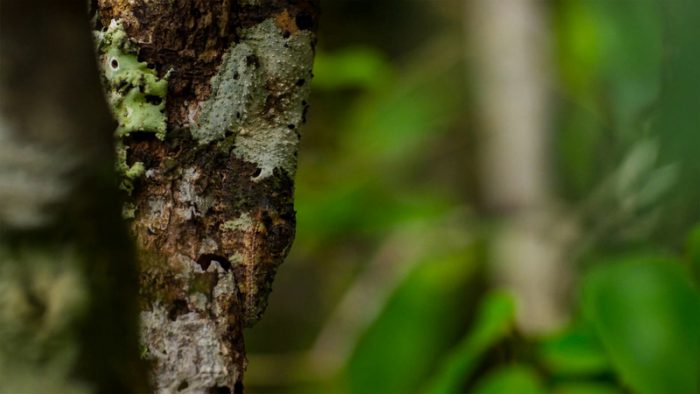Outside of certain fish and insects, it's tough to think of animals that can camouflage as well as lizards. From exceptionally detailed mottled skin patterns, to strange appendages that perfectly imitate their environment, certain lizards are able to simply disappear.
Take the various species of leaf-tailed geckos (genus Uroplatus—say YUR-oh-PLAH-tus). These curious critters are masters of disguise—despite their name, their entire bodies are able to blend in seamlessly with piles of dead leaves on the forest floor or on the bark of trees. There they lay motionless, waiting for the nighttime when they can hunt the insects that make up their diets.
Recently, a team discovered a brand new species of leaf-tailed gecko—Uroplatus finaritra.
Meet the beautiful #newspecies of leaf-tailed #gecko, described today in @Zootaxa! #Uroplatus finaritra!
We call for all @CITES animals in the pet trade from #Madagascar to mandatorily be accompanied by collection location data—it facilitates species ID!https://t.co/JDkXUlygXG pic.twitter.com/D8LJ2tSMQf— Mark D. Scherz (@MarkScherz) January 21, 2019
In honour of this, we thought that we'd take a little tour of their hidden world.
Let's geck-going!
The genus name for Leaf-tailed geckos is Uroplatus. It comes from two words in Greek—ourá and platys—meaning "tail" and "flat". And these animals do indeed have flat, generally leaf-shaped, tails. But it's the stunning details of their camouflage that really sets them apart from most of the animal world.
This fellow is called the Fantastic leaf-tailed gecko. We agree! Look at how perfectly it mimics a dead leaf, right down to the wilted and 'cracked' tail—exactly like a dead leaf! (Getty Embed)
The Uroplatus leaf-tailed geckos live only in Madagascar. But the Southern leaf-tailed gecko of Australia (that's genus Phyllurus, if you're keeping score at home!) shows that the animal's unique methods found its way to other parts of the world, too. (Getty Embed)
Henkel's leaf-tailed gecko (Uroplatus henkeli) of Madagascar has a unique 'beard' that hugs the surface of the tree for exceptional camouflage. (Getty Embed)
Please don't blame the Satanic leaf-tailed gecko for its name. It's not evil. It just wants to hide in the leaves! (Getty Embed)
What's that? Show's over? Okay, okay ... we'll let you be, geckos! (Getty Embed)
 Can you see the leaf-tailed gecko? If not, no worries—most of us are fooled by these masters of disguise! (© Tignogartnahc - Dreamstime.com)
Can you see the leaf-tailed gecko? If not, no worries—most of us are fooled by these masters of disguise! (© Tignogartnahc - Dreamstime.com)









